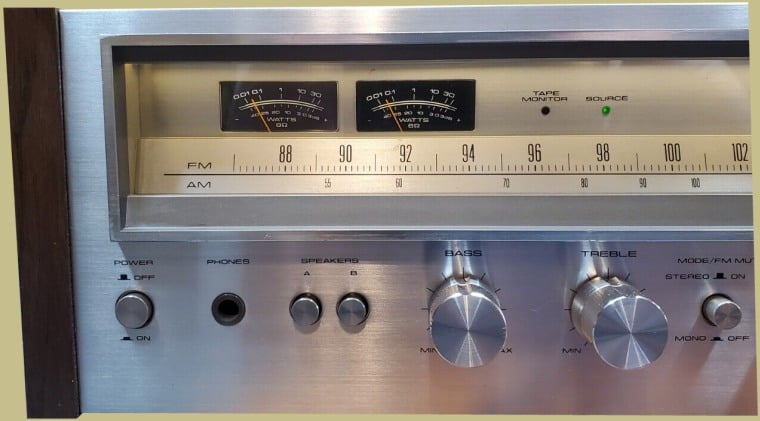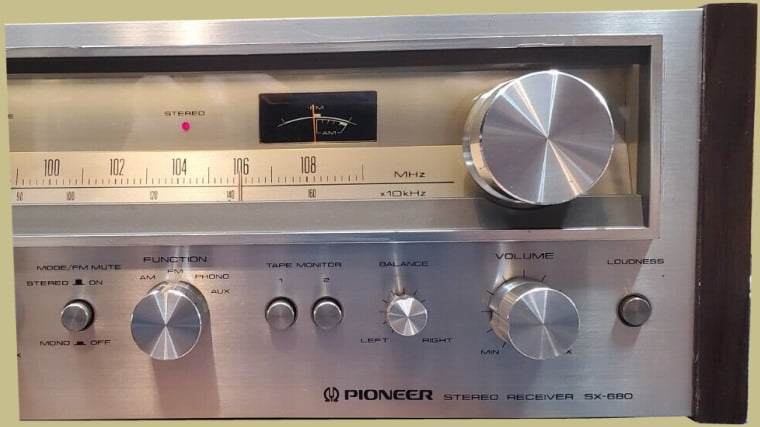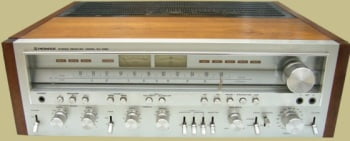
This is the Pioneer SX-680 receiver. It was introduced by Pioneer in 1978 and was on the market until about 1980. It is a descendant of the SX-650. It retailed for about $199 and produced 30 watts per channel. It was at the lower end of the x80 line from Pioneer that year but had the features most consumers would need and performed above its specifications. The entry level receiver was the SX-580, followed by the SX-680, SX-780, SX-880, SX-980, SX-1080, and the legendary monster SX-1980.

The light metallic dial face (almost white) and black meter faces give it an interesting look. The dial illumination is a clear, warm white. Its precursor, the SX-650, had the same light dial face but had white meter faces. The meters on the SX-650 are also at the center of the dial face rather than to the left as on the SX-680.

Another change was to a push button power switch instead of the knob style switch on the SX-650. In fact, a number of the controls switched from toggle switches on the SX-650 to push button controls on the SX-680. As mentioned above the SX-680 was basically an entry level or budget minded receiver so its features are limited. It has bass and treble but no mid-range control, a mute/stereo control, a function switch, tape monitor push buttons, balance knob and a loudness button. That’s it.
It is strange though, given its minimal features, that it has dual power meters. Dual power meters for a 30 watt per channel receiver?

The meter on the right is a signal strength meter. The SX-680 has Pioneer’s usual large tuning knob. Pioneer called the organization of the front panel on the SX-680 the “Hallmark of handling ease.” The wood top and side panels have a simulated wood grain vinyl covering. It’s not great quality and tends to flake and chip over the years.
Specifications:
- Tuning range: FM, MW
- Power output: 30 watts per channel into 8Ω (stereo)
- Frequency response: 5Hz to 100kHz
- Total harmonic distortion: 0.1%
- Damping factor: 25
- Input sensitivity: 2.5mV (MM), 150mV (line)
- Signal to noise ratio: 75dB (MM), 90dB (line)
- Output: 150mV (line)
- Speaker load impedance: 4Ω (minimum)
- Dimensions: 17 1/8″ W x 5 11/16″ H x 12 3/8″ D (435 x 144.5 x 314mm)
- Weight: 19 lbs 10 ounces (8.9kg)
The FM tuner in the SX-680 uses a 3-gang variable capacitor and a dual gate MOS FET to provide a high gain, low noise, and high sensitivity tuner. Pioneer describes the power amplifier in the SX-680 this way:
The first stage differential amplifier and all-stage direct-coupled quasi-complimentary OCL circuit power amplifier is packaged as a single IC and it delivers a continuous power output of 30 watts per channel and 8 ohms or 37 watts per channel at 4 ohms from 20 hertz to 20000 hertz with no more than 0.1% total harmonic distortion. This is an amplifier that packs an ample power punch.

While some argue, rightly so, that the SX-680 isn’t built quite as well as the SX-650, it’s still a well built stereo. It does have some issues though. It utilizes STK-0039 power packs in the output section and they are known to fail. Finding an OEM replacement can be problematic. There are new replicas available but their quality is considered dubious by some, though I have read of some SX-680 owners using them successfully. They are inexpensive so they might be worth a try. You can find the new version of the STK-0039 power packs on eBay HERE. I believe that the SX-880 and up didn’t use the STK power packs but instead incorporated discrete components.
If you’re planning on recapping your SX-680 keep in mind that the big caps on the power supply board have three legs soldered to the board. One of the legs seems to only be for anchoring the cap. But, if you don’t notice it and de-solder the other two legs and then pry on the cap, thinking it should be free, you may crack the board. Full recap kits for the SX-680 are available on eBay as well as lamps.
The SX-680 has a nice layout inside but the main board is pretty tightly packed with components and sits snuggled between the front panel and heatsink wall which makes it difficult to access.

The Pioneer SX-680 is a good receiver. It gets very good FM reception, clean AM, and has a big sound for its size and specifications. It has inputs for phono, tape and AUX so it’s a great starter receiver. Pair it up with a good turntable and it will make a good audio setup for an office, bedroom, or den. In short, it’s simple to operate, has nice clean styling, a classic vintage silver faced look, plenty of power, and can be found these days at a reasonable price.


It is a good receiver, frankly, I like the SX 650 a lot better, toggles instead of pushbuttons,
and trying to look like a big shot with wattmeters when the output is 30 watts per channel!
Damn, I might need a sparky to put in a dedicated circuit for this receiver! it is just funny as my Kenwood KR6030 belts out close to 3X this SX680 yet does not sport wattmeters.
Still, though it is a very good brand of receiver, good for a kitchen set-up or a den or a study.
Hello…
And thanks in advance if anyone can offer information to a non-audiophile. I am the original owner of an SX680 purchased in 1979. Recently pulled the receiver out of 25 year plus storage. It lit up when powered on. However, after connecting the receiver to two different pairs of speakers, the only sound produced was a moderate and consistent hum. The hum could not be adjusted by the volume control. Same consistent hum was present regardless, if trying to tune to AM, FM or connected to it’s vintage Technics M218 cassette player. Please note, the unit’s original FM antenna, ground wire was not located and has not been attached. Is there a remedy for an amateur to deal with, or is the SX680 unrepairable?